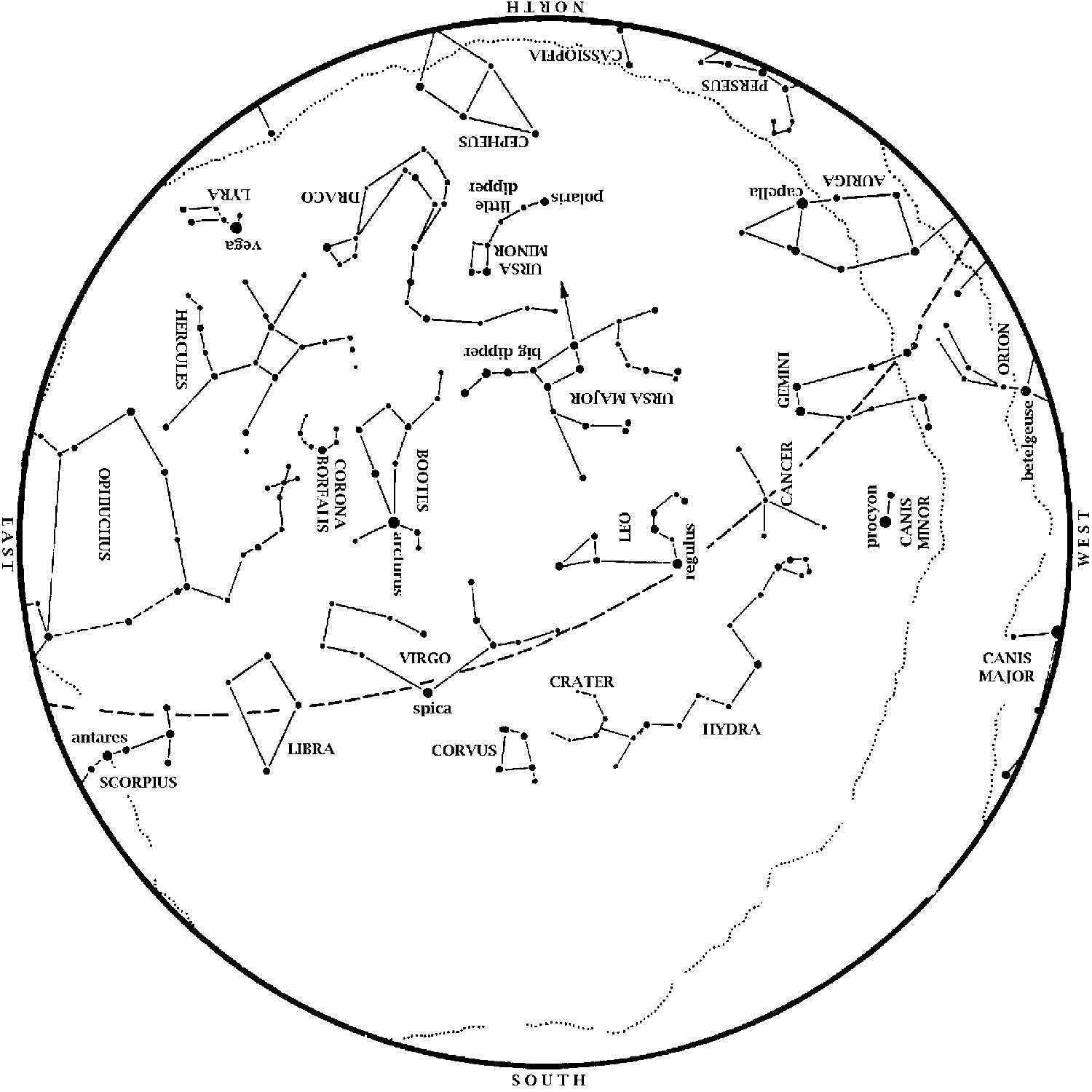Jupiter is now high in the south at dusk. It outshines all stars we ever see at night, so you can’t miss it.
Mars and Saturn become late evening objects this month. Tonight, May 2, Mars rises in the southeast at 9:48 p.m. while Saturn comes up soon afterwards, at 10:24 p.m. By May 15, though, both planets rise during twilight, and on Memorial Day both are in the southeastern sky as soon as it gets dark. Mars and Saturn are still above the distinctive pattern of Scorpius, the scorpion. As you watch them rise, Mars is to the upper right and is much brighter.
In fact, this month, Mars outshines all of the stars and even rivals Jupiter in brightness! That’s because on May 22, Earth passes between the Sun and Mars. That alignment is called ‘opposition’ because it puts Mars opposite the Sun in our sky, making Mars visible literally all night long. It also makes Mars much brighter than normal in the sky, since we’re as close to it as we’ll ever get until Earth overtakes Mars again in 2018. Saturn comes to opposition June 3.
Venus is lost in the Sun’s glare and out of sight all month.
A swath of brilliant winter stars sets in the west at dusk. Orion, the Hunter, is still visible in the west as May begins. His two dogs, represented by Sirius and Procyon, are to his left. Gemini, the Twins, are above Orion. The Big Dipper is above the North Star, with its handle pointing to the right. From that handle, you can ‘arc to Arcturus’ and then ‘speed on to Spica’; those stars are high in the east and in the south, respectively, at dusk. Leo, the Lion, passes almost overhead at dusk.
As Orion and his dogs set, look for Antares, the brightest star in Scorpius, the Scorpion, to rise in the southeast. Saturn and Mars will rise with the Scorpion’s head, above Antares. At the same time, Vega, brightest star of the Summer Triangle, appears low in the northeast. These stars remind us that summer is on the way.
Moon Phases in May 2016:
New: May 6, 2:30 p.m.
First Quarter: May 13, 12:02 p.m.
Full: May 21, 4:14 p.m.
Last Quarter: May 29, 7:12 a.m.
Mercury Transit:
On Monday, May 9, 2016, Mercury overtakes Earth on its much faster orbit. This time, though, when Mercury passes Earth, the alignment is almost exact, such that Mercury appears in silhouette against the sun’s disk. This event is known as a transit of Mercury. Keep in mind that the planets are almost, but not exactly, in the same plane. Indeed, Mercury’s orbit is the most inclined — tilted up to 7 degrees from Earth’s orbital plane. That’s why Mercury does not usually transit the sun when it overtakes Earth. Monday’s event is therefore rare and special, occurring only 14 times in the 21st century (the next one occurs Nov. 11, 2019).

Thus, weather permitting, the Houston Museum of Natural Science has arranged for volunteers from local astronomy clubs to set up solar telescopes outside our museum’s main entrance, near the sundial, to show you the transit. Mercury, already in the sun’s disk by sunrise in Houston, takes until 1:42 p.m. to cross to the other side of the sun’s disk. If skies cooperate, we’ll observe the transit from 10 a.m. until 1:42 p.m. on Monday, May 9. If there are sunspots on the sun’s disk while Mercury is there, Mercury will stand out because its disk is fully round and because Mercury moves noticeably across the sun’s disk during the hours we’re watching.
We will observe the sun (and Mercury in silhouette) through telescopes with filters especially designed to filter the sun safely, and by projecting the sun’s image onto a screen. These are the only two ways to observe the Sun safely. Please do not try to observe the sun directly or through an unfiltered telescope, as this will lead to permanent eye damage or blindness. Our common sense tells us this because we always avert our eyes when we accidentally turn towards the Sun. When something cool happens on the sun, some of us try to override our common sense, and there is no reason to do so. Come observe safely with us.
On most clear Saturday nights at the George Observatory, you can hear me do live star tours on the observation deck with a green laser pointer. As of now, George is closed which Brazos Bend State Park dries out from last month’s floods, and is scheduled to reopen May 10. If you’re there, listen for my announcement.







